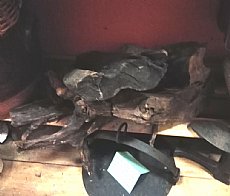Prehistoric cut wood from near Loch Farlary, Golspie
01 April 2020
- News Type:
- Find of the Month

This prehistoric pine stump was found near Loch Farlary near Golspie in Sutherland. It is one of eleven grown in the late Neolithic but cut with metal axes. Further work in the area with a number of environmental core samples provided a landscape context for this find, and identification of a number of short-lived events, probably the result of regional climate shifts and human activity.
In this area, blanket peat formed and spread rapidly between 7050 and 6500 cal BC in the Mesolithic period, suggesting an exceptional wet phase which Richard Tipping suggested occurred c. 8250 – 7850 cal BC for northern Scotland. Local vegetation began to appear c. 6500 cal BC. There then followed drier conditions for the following 2,000 years. Pine appeared around c. 6000 cal BC and expanded rapidly, late compared with some other places regionally but comparable to Lairg. This occurred in drier conditions, but the peat had been dry for 500-600 years before, so the colonisation was not triggered by climate change.
Climate changes, with a number of short-lived events, and the first pine decline can be identified after 4900 BC, with pine rare after c. 4000 BC, a trend identified in other sites in the region. A decline in elm c. 3550-3050 cal BC (early Neolithic) coincides with dates found elsewhere in the region; at Farlary there is no indication of external stresses causing this, or evidence of human woodland disturbance or farming.
In the later Neolithic there was another decline of woodland pollen, and this has been attributed to human clearance. Pine recolonised on the bog c. 3050 cal BC after a gap of around 1000 years. Eight of eleven cut-marked timbers died between c. 3050 and 2450 cal BC, with most between c. 3000 and 2650 BC. This is before metalworking was introduced to Great Britain, yet the wood was all cut by metal axes, the earliest cut dating to c. 2250 cal BC. This means that the timbers must have been worked after the trees had died. Cutting could have taken place at different times.
Pine continued to grow at Farlary after 2050 cal BC, at a time when further to the north and west in northern Scotland it no longer grew on bogs. It started to decline after c. 2080 cal BC, and continued gradually until c. 1550 cal BC. It was probably locally extinct by 1250 cal BC (Middle Bronze Age). At some sites in northern Scotland the second pine decline occurred over a short time, but at Farlary it was gradual.
The reasons for this second decline are unclear, but is often attributed to climatic reasons causing the watertable in bogs to rise. However, there is some debate on this. At Farlary, an increase in the bog surface wetness was not concurrent with the pine decline. The tephra from Heckla 4 was several hundred years before the second pine decline, so is unlikely to be related to the decline. After c. 1550 cal BC there was increased grazing pressures and over the next few hundred years, evidence of human activity including burning. The samples suggest that by 1050 cal BC (Late Bronze Age) all trees had been removed from the area. This period relates to the archaeological remains of round houses, field systems and burnt mounds, and intensive farming, as at Lairg. It is in this context that the axe marks have been linked, as timbers may have been removed during peat cutting.
This study shows the great value in having well dated cores, and multi-foci analysis of pollen, macrofossil and tephra analyses to reconstruct the local environment, aiding in the interpretation of whether climatic or human activity was responsible for changes. The study is also of interest showing that even in northern Scotland, the survival or decline of pine can be quite different in different locations. It also highlights that old wood can be used, and highlights the need for careful analysis and interpretation.
Pieces of the pine can be found at Golspie Heritage Centre and in the National Museums of Scotland
Further details:
Tipping, Richard et al 2008. ‘Prehistoric Pinus woodland dynamics in an upland landscape in northern Scotland: the roles of climate change and human impact’, Veget Hist Archaeobot 17, 251-267.
Find of the Month Archive
- 25/07/2022 Steatite Vessels
- 10/04/2021 Cruisie lamp in Dunrobin Castle Museum
- 02/03/2021 Medieval Sword Pommel from Sleat, Skye
- 01/02/2021 Hilton of Cadboll Pictish Cross Slab
- 04/01/2021 Gunflint from Stoneyfield, Inverness
- 02/12/2020 Bobbin from Contin Bobbin Mill
- 02/11/2020 Russian Lead Cloth Seal from Cromarty
- 01/10/2020 The Poolewe Hoard
- 04/09/2020 Storr Rock Viking Silver Hoard
- 07/08/2020 Mesolithic bloodstone artefacts from Camas Daraich, Skye
